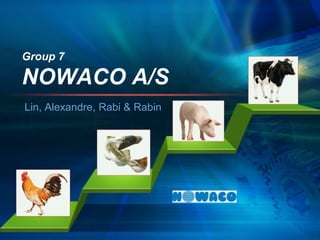How to integrate sustainability, social responsibility and globalization in your organization.
- 1. Group 7NOWACO A/SLin, Alexandre, Rabi & Rabin
- 2. IntroductionData collection methodProblem statement Criticism of methodsInterpretation & limitationsAnalysis of 4 challenges ScopeEvaluationMethodologyFinal ConclusionCONTENTS29-05-2011Lin, Alex, Gurudattta & Rabin2
- 3. Company introductionNOWACO A/SBusiness areas: Producing and trading frozen food & foodstuffs worldwideFrozen food: Pork, poultry, beef, fish & sea foods, vegetables and dried foodsFish factory in china and trading offices in 11 countries29-05-2011Lin, Alex, Gurudattta & Rabin3
- 4. Problem statementWhat's NOWACO's current business process and strategy? How company manages to meet following challenges now or in the future?How can NOWACO contribute to environmental sustainability in managing their business?How can NOWACO improve their social responsibility in managing their business?How can NOWACO employs shared information through the learning organization?How can NOWACO integrate globalization and glocalization on managing their global supply chain?29-05-2011Lin, Alex, Gurudattta & Rabin4
- 5. Interpretation & limitationsNOWACO A/S fulfils all the requirement of semester projectsInformation's are limited for not allowing to contact companyBusiness law and organizational management arenot included in the project among the courses taught in 1st semester29-05-2011Lin, Alex, Gurudattta & Rabin5
- 6. ScopeGives general overview of the company's business processes and solutions to the business challenges we decided to work on29-05-2011Lin, Alex, Gurudattta & Rabin6
- 7. To structure the projectResearch onionImplement new strategiesOverview of company's business process and strategyJohn R. Schermerhorn modelBridge to profitModelsBenchmarkingWhale curve & ABC analysisOptimizing supply chainMost profitable customers and suppliersLean principleHow future supply chain should beMethodology29-05-2011Lin, Alex, Gurudattta & Rabin7
- 8. Data Collection MethodSecondary/desk researchSearch engines: data monitor, market line, OECD and different academic journals, reports and articles29-05-2011Lin, Alex, Gurudattta & Rabin8
- 9. Criticism of methodsProject is entirely based on secondary dataReliability of Internet sourceSuggestion for quantitative research29-05-2011Lin, Alex, Gurudattta & Rabin9
- 10. The analysisCustomer interface: Strong relationship, exhibition, worldwide representative officeCore strategy: Guaranteed quality and delivery on time, trading and distributing broad multi-temperature product range globallyStrategic resources: Extending and financing deals for the company as a wholeValue network: 9 representative offices worldwide, administration, shipping and finance in Denmark, most raw materials from north America29-05-2011Lin, Alex, Gurudattta & Rabin10
- 11. Environmental sustainabilityAnalysis based on sister company “Bidvest food business”Commitments: Achieved ISO 20000, reduce green house effect, use of renewable energy resources, support to partners for supply chainHypothesis: Applied ISO 20000 and ISO 14064Bidvest long-term issues: Reduce environmental impacts; particularly carbon impact, healthier and sustainable foods, robust information on food labelling, demand for local and seasonal product29-05-2011Lin, Alex, Gurudattta & Rabin11
- 12. Social responsibilityBuy pieces that aren't genetically modified, farmed in sustainable environment and grown without growth hormonesEfficient wastes management e.g. delivering parts of chicken and pork's to china from EuropeThreats of bad Labour image and stereotypes about those (BRIC) countries29-05-2011Lin, Alex, Gurudattta & Rabin12
- 13. Globalization & GlocalizationMarkets: Suppliers: 29-05-2011Lin, Alex, Gurudattta & Rabin13
- 14. 2015Packaging: chilled processes, frozen processes and canned/preserved; flexible, looking attractive, looking better convey an image of freshness and quality2015Distribution centre: 67.7%-supermarkets, 17.2% independent retailers, 17.2% convenience store, china, Russia and Indonesia shows market growth2010 ~ 2015Frozen meat accounts 41.3% of market’s value, brazil food S:A., Nestle S.A. & H.J. Heinz consist market share 5%, 2.8% and 1.9%2010Growth expectedMarket grow by 3.5% and expected to be 14.5% in 2015, Europe, Asia pacific and America consist 3 biggest market segmentGlobal frozen food market29-05-2011Lin, Alex, Gurudattta & Rabin14
- 15. Knowledge - sharingCase with Russian customerHelped him to send raisins back from Afghanistan to Russia and bought one sort of raisins from him while selling other sorts to himCase with Chinese customerVisiting at Danish slaughterhouse came up with the idea of selling non used parts of chicken and pork's to china which is considered to be delicacy in Europe29-05-2011Lin, Alex, Gurudattta & Rabin15
- 16. Learning organization practiceWorking for better performance and quality controlLong-lasting partnerships, having flexible human resources wellness and keeping employee healthyIncentives to the employees such as healthy lunch, fresh fruits, in house exercise class etc.29-05-2011Lin, Alex, Gurudattta & Rabin16
- 17. The evaluationExplains what NOWACO can do about these challenges and how they can implement the suggestions that we have presented29-05-2011Lin, Alex, Gurudattta & Rabin17
- 18. Environmental sustainabilityCustomer awareness: Follow cradle-to-grave policy, label on how to dispose or recycleBenchmark: Benchmark for being environmental sustainableWork force: Train employees for being environmental sensitive, alternative travel arrangement, work from remoteLogistics: Implement LEAN thinking for reducing wastes and CO2 emissions29-05-2011Lin, Alex, Gurudattta & Rabin18
- 19. Social responsibilityExample with the frozen fish delivered to Qingdao: cuts logistics part thus reduce environmental impactApply ISO 26000Sign up for, principle for responsible investment(PRI)Write code of conduct29-05-2011Lin, Alex, Gurudattta & Rabin19
- 20. Globalization & GlocalizationLogistics perspectives: Plan to handle implications of international logistic; inventory, handling and transportRisks management of geographical threats and transport breakdownsEvaluate multiple modes and cost optionsApply LEAN thinking for reducing supply chain cost, improve quality and to get rid of 7 wastesChoosing right customers; ABC calculation and benchmarking29-05-2011Lin, Alex, Gurudattta & Rabin20
- 21. Sharing knowledge Create global virtual team29-05-2011Lin, Alex, Gurudattta & Rabin21
- 22. How to create learning organizationMechanical system design --> Natural system designAwareness: Importance of it, from top management to blue collar workersOrganization structure: Flat structure encourage innovations, openness, reflectivityLeadership: Help to guide the organization towards learningEmpowerment: Empower employees & make responsible for their own workLearning: Flexible and encouraging organization so that people feel free to learn from the mistake29-05-2011Lin, Alex, Gurudattta & Rabin22
- 23. Final conclusionEnvironmental sustainability: Apply ISO 26000 cutting unnecessary transport, code of conduct to implementSocial responsibility: Cradle to grave policy, make employee aware of green cause, benchmark against competitorsGlobalization and glocalization: Apply LEAN thinking, benchmarking for optimizing performance, strategy for future growth expectedKnowledge sharing: From mechanical to natural system designFuture scenario: 14% grow in 2015, constant growth over the period29-05-2011Lin, Alex, Gurudattta & Rabin23
- 24. Lin, Alex, Gurudatta & RabinGroup - 7Thank – you
























